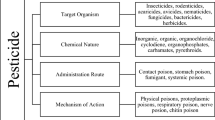Abstract
Alkylphenols are common endocrine disrupters that are produced from the degradation of widely used surfactants. Since they cause various harmful effects on aquatic life and in humans, they should be removed from the environments being contaminated. White rot fungus Irpex lacteus can completely degrade 100 mg/L of octylphenol, nonylphenol, and phenylphenol during 1 day of incubation in the complex YMG medium, which was the highest degrading capability among nine strains of white rot fungi tested. In the N-limited Kirk’s basal salts medium, I. lacteus could degrade almost 100 % of 100 mg/L octylphenol and nonylphenol in 1 h, and exhibited a high activity of manganese peroxidase (MnP; 1,790 U/L). MnP of I. lacteus was purified by ion exchange chromatography, and this degraded 99 % of 50 mg/L octylphenol and removed 80 % of estrogenic activity in 2 hours. In addition, the purified MnP (10 U/mL) degraded over 90 % of 50 mg/L nonylphenol in 1 h.




Similar content being viewed by others
References
Baborová, P., Möder, M., Baldrian, P., Cajthamlová, & Cajthaml, T. (2006). Research in Microbiology, 157, 248–253.
Cabana, H., Jiwan, J.-L., Rosenberg, R., Elisashvili, V., Penninckx, M., Agathos, S., et al. (2007). Chemosphere, 67, 770–778.
Cajthaml, T., Křesinová, Z., Svobodová, K., & Möder, M. (2009). Chemosphere, 75, 745–750.
Farnet, A., Chevremont, A., Gil, G., Gastaldi, S., & Ferre, E. (2011). Chemosphere, 82, 284–289.
Frederic, H., Sheng, D., & Gold, M. (1996). Biochimica et Biophysica Acta, 1297, 139–148.
Gabriel, F., Giger, W., Guenther, K., & Kohler, H.-P. (2005). Applied and Environmental Microbiology, 71, 1123–1129.
Junghanns, C., Moeder, M., Krauss, G., Martin, C., & Schlosser, D. (2005). Microbiology, 151, 45–57.
Kim, H.-Y., & Song, H.-G. (2003). Applied Microbiology and Biotechnology, 61, 150–156.
Limongi, P., Kjalke, M., Vind, J., Tams, J., Johansson, T., & Welinder, K. (1995). European Journal of Biochemistry, 227, 270–276.
Mielgo, I., Palma, C., Guisan, J., Lafuente, R., Moreira, M., Feijoo, G., et al. (2003). Enzyme and Microbial Technology, 32, 769–775.
Nishikawa, J., Saito, K., Goto, J., Dakeyama, F., Matsuo, M., & Nishihara, T. (1999). Toxicology and Applied Pharmacology, 154, 76–83.
Saito, T., Kato, K., Yokogawa, Y., Nishida, M., & Yamashita, N. (2004). Journal of Bioscience and Bioenginnering, 98, 64–66.
Sklenar, J., Niku-Paavola, M., Santos, S., Man, P., Kruus, K., & Novotny, C. (2010). Enzyme and Microbial Technology, 46, 550–556.
Soares, A., Guieysse, B., Jefferson, B., Cartmell, E., & Lester, J. (2008). Environmental International, 34, 1033–1049.
Soares, A., Jonasson, K., Terrazas, E., Guieysse, B., & Mattiasson, B. (2005). Applied Microbiology and Biotechnology, 66, 719–725.
Takeo, M., Prabu, S., Kitamura, C., Hirai, M., Takahashi, H., Kato, D., et al. (2006). Journal of Bioscience and Bioengineering, 102, 352–361.
Tanaka, T., Nose, M., Endo, A., Fujii, T., & Taniguchi, M. (2003). Journal of Bioscience and Bioengineering, 96, 541–546.
Tanghe, T., Dhooge, W., & Verstraete, W. (2000). Biodegradation, 11, 11–19.
Tien, M., & Kirk, T. (1988). Methods in Enzymology, 161, 238–249.
Tsukihara, T., Honda, Y., Sakai, R., Watanabe, T., & Watanabe, T. (2006). Journal of Biotechnology, 126, 431–439.
Tsutsumi, Y., Haneda, T., & Nishida, T. (2001). Chemosphere, 42, 271–276.
Vincent, M., & Sneddon, J. (2009). Microchemical Journal, 92, 112–118.
Wang, Y., Rafael, V., & Michael, A. (2002). Current Microbiology, 45, 77–87.
Xiaobin, X., Rong, J., Pingsheng, L., Shiqian, T., Qin, Z., Wenzhong, T., et al. (2007). Enzyme and Microbial Technology, 41, 258–264.
Yeo, S., Park, N., Song, H.-G., & Choi, H. (2007). Journal of Microbiology, 45, 213–218.
Acknowledgments
This study was supported by the Korea Ministry of Environment as “The Eco-Technopia 21 Project” (grant no. 031-071-030).
Author information
Authors and Affiliations
Corresponding author
Rights and permissions
About this article
Cite this article
Moon, DS., Song, HG. Degradation of Alkylphenols by White Rot Fungus Irpex lacteus and Its Manganese Peroxidase. Appl Biochem Biotechnol 168, 542–549 (2012). https://doi.org/10.1007/s12010-012-9795-4
Received:
Accepted:
Published:
Issue Date:
DOI: https://doi.org/10.1007/s12010-012-9795-4




